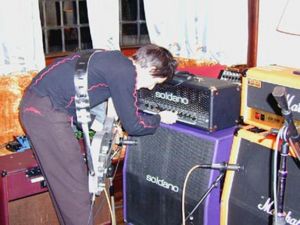Difference between revisions of "Matchless"
m (s/Image/File; s/On/In; Backto template; move from Amplifier cat to Amplifiers cat; rm from Gear cat) |
|||
| (2 intermediate revisions by 2 users not shown) | |||
| Line 1: | Line 1: | ||
[[File:Pd soldanoadjust.jpg|thumb|right]] | [[File:Pd soldanoadjust.jpg|thumb|right|Matchless DC30 in the background (at the bottom left)]] | ||
This amplifier was used during 1999. {{YTw |wT1SucCxVTc|35}} | |||
The preamp sections are based on a layout of two 12AX7's in Channel 1 and one EF86 in Channel 2. The | The DC30 is Matchless's first design and it is still produced. | ||
The preamp sections are based on a layout of two 12AX7's in Channel 1 and one EF86 in Channel 2. The two 12AX7's in Channel 1 create a parallel-triode circuit with interactive bass and treble. The one EF86 in Channel 2 consists of a high-gain pentode coupled to a six-position tone switch. | |||
Outright benefits include quick dial-in of new tones and an easy return to the settings you learn to prefer. Also included is a ''high treble'' cut control and master volume, with a bypass feature that offers flexible control of the power amp section. The power amp is fed by a 12AX7 phase inverter, which drives four EL84 power tubes. | |||
The rectifier circuit gives you the flexibility of using one 5AR4 for a quick attack or you can use two 5V4's for a smooth round response. | |||
Other professional features include an effects loop, half power-mode switch (a conservative 30 watts switching to 15 watts), output impedance selector (4,8 or 16 ohms) and a speaker phase-reverse switch. | |||
{{Backto | amplifiers}} | {{Backto | amplifiers}} | ||
[[Category:Amplifiers]] | [[Category:Amplifiers]] | ||
Latest revision as of 05:27, 14 June 2019
This amplifier was used during 1999. [watch]
The DC30 is Matchless's first design and it is still produced.
The preamp sections are based on a layout of two 12AX7's in Channel 1 and one EF86 in Channel 2. The two 12AX7's in Channel 1 create a parallel-triode circuit with interactive bass and treble. The one EF86 in Channel 2 consists of a high-gain pentode coupled to a six-position tone switch.
Outright benefits include quick dial-in of new tones and an easy return to the settings you learn to prefer. Also included is a high treble cut control and master volume, with a bypass feature that offers flexible control of the power amp section. The power amp is fed by a 12AX7 phase inverter, which drives four EL84 power tubes.
The rectifier circuit gives you the flexibility of using one 5AR4 for a quick attack or you can use two 5V4's for a smooth round response.
Other professional features include an effects loop, half power-mode switch (a conservative 30 watts switching to 15 watts), output impedance selector (4,8 or 16 ohms) and a speaker phase-reverse switch.
